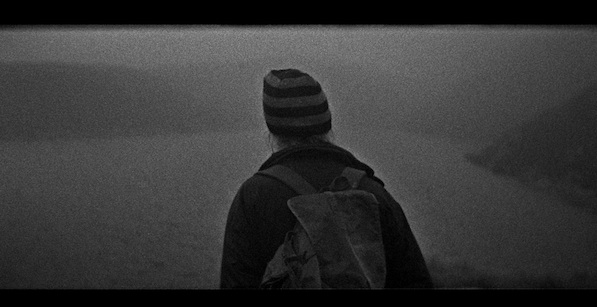Widescreen and nearly wordless, Two Years at Sea (2011) is documentary portraiture as a dream of life, its palpitating handmade aesthetic radiating a broad sympathy for its solitary subject, Jake Williams. Filmmaker Ben Rivers approaches lived spaces as archaeological sites, excavating their relics and points of view for a sense of duration. In the case of Williams, a gentle, bearded man living in the woods who previously featured in Rivers’ short This is My Land (2006), the ramshackle dwelling speaks of a lifetime of ingenious fixes and off-kilter innovations. Two Years at Sea opens on a familiar scale of the everyday—Williams walking through the snow, waking, showering—but moves from there into an open conception of time and possibly into dream. A small trailer appears pitched in the trees, like a Highlands Calvino, while Williams’ readiness to catnaps calls Thoreau to mind: “It is not necessary that a man should earn his living by the sweat of his brow, unless he sweats easier than I do.” [Editor’s note: Ben Rivers and Ben Russell‘s collaborative effort, A Spell to Ward off the Darkness, plays TIFF.]
Rivers’ hand-processed cinematography is the most immediately identifiable aspect of his style, reflecting an underlying conviction in the material beauty of film itself, but his work is also marked by a perspicacious, subtly disorienting form of cutting. In Two Years at Sea, he skips between seasons and objects while leaving the overall space vaguely defined, the better to renew an initial sense of encounter. Rivers cuts on sound both to create a sense of depth (the relative distance from a phonograph speaker or a steaming kettle) and a lyrical fabric for the images (the surprising aural echo of boots in the snow and rustling covers). In the absence of exposition, this poetic conception of space offers a different measure of familiarity.
Rivers readily admits seeing an affinity between his own self-sufficient vision of cinema and Williams’ evident resourcefulness. This analogy between filmmaker and subject seems especially direct in the passages interspersed throughout the film when Rivers’ camera contemplates one of Williams’ old snapshots. Besides gesturing towards a life lived beyond the scope of the film, the artist’s approach to collage perfectly aligns with the subject’s habit of collecting. With this parity in mind, the semi-mythic characterization firing Two Years at Sea should be read as much in terms of Rivers’ own desire for a certain kind of cinema as Williams’ actual lifestyle. Williams’ solitude may be mere projection, but the reverie evoked in the viewer is real enough.
The filmmaker wryly implicates the slippage between style and subject towards the close of a long take (one of two shots in the film that persist for the length of a complete roll of film). After following Williams as he lugs his materials for an ad hoc raft through the woods, we finally watch him set off onto a lake and come to a floating rest. As the boat inches towards the right edge of the frame, we come to expect that the shot will end when Williams exits the frame and the lake returns to its former placidity. Instead, Williams paddles back towards the center of the frame just as he comes to the edge, a jarring reminder of the existence of a director.
If the raft shot suggests a restricted conception of space and time, the one immediately following it cuts loose from the laws of perspective to express a state of mind normally too delicate to survive as cinema. Jake floats on his raft filmed from above, the silvery water swirling as pure film stock without any reminder of actual land. He could just as easily be floating in the sky: a diaphanous image such as one might find in Jean Vigo’s films and one of many examples of Rivers’ assured use of undefined space. Expanses of black, white and grey blanket the ‘Scope frame, a visual corollary for the imaginative space imbued by the long takes and intimacy of sound.
The symbiosis of this imaginative space with Williams’ physical reality peaks in the magnificent final shot of Jake sitting by the fire, the second single-roll take. Williams’ face fills the right side of the frame, lit by the flames below; offscreen and flickering, the fire directly relates to the projector. The deepening shadows open the frame to the scratches and specks of dirt that are the natural result of Rivers’ hand-processed technique, the crackling sound of the fire providing apt aural accompaniment for the visual sparks. Williams’ face gradually disappears into the darkness—of night, of cinema. Whether read as an elegy for material celluloid or a tribute to the irreducible presence of the human visage, Rivers’ slow fade delivers us back to the primitive magic of cinema.






